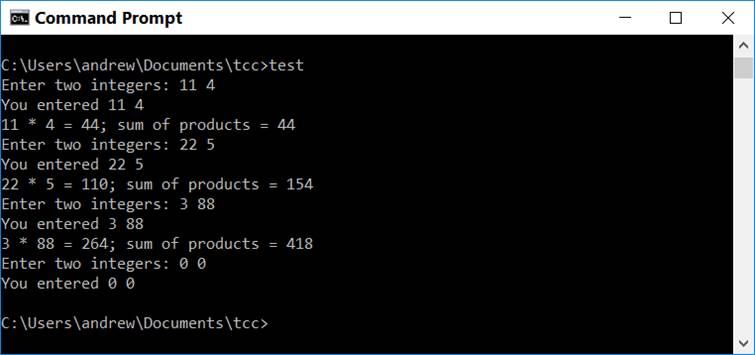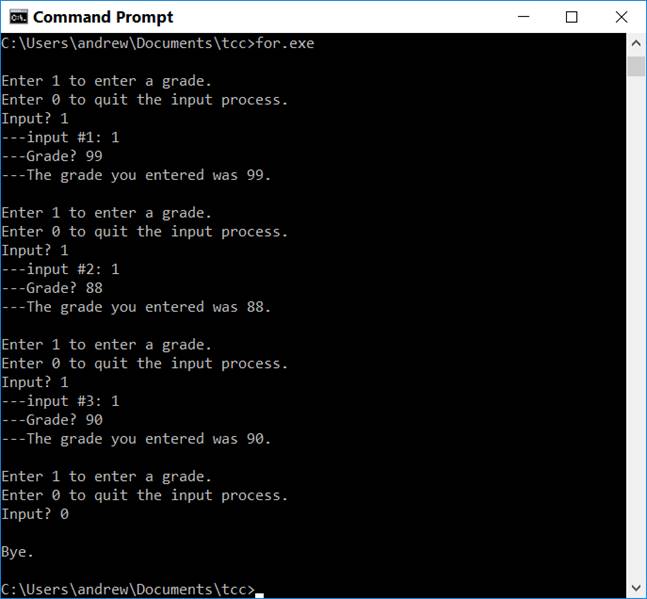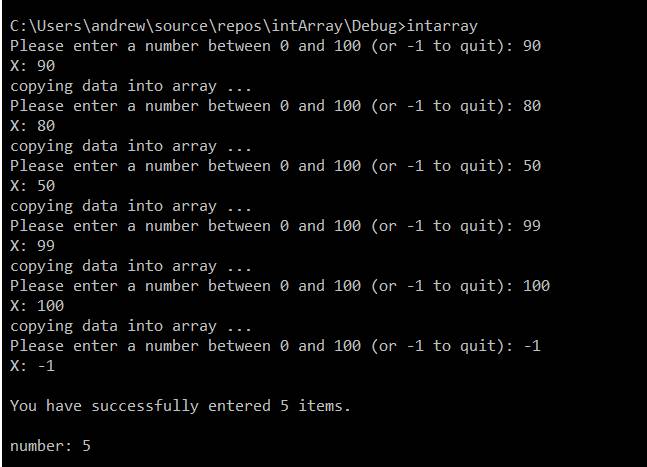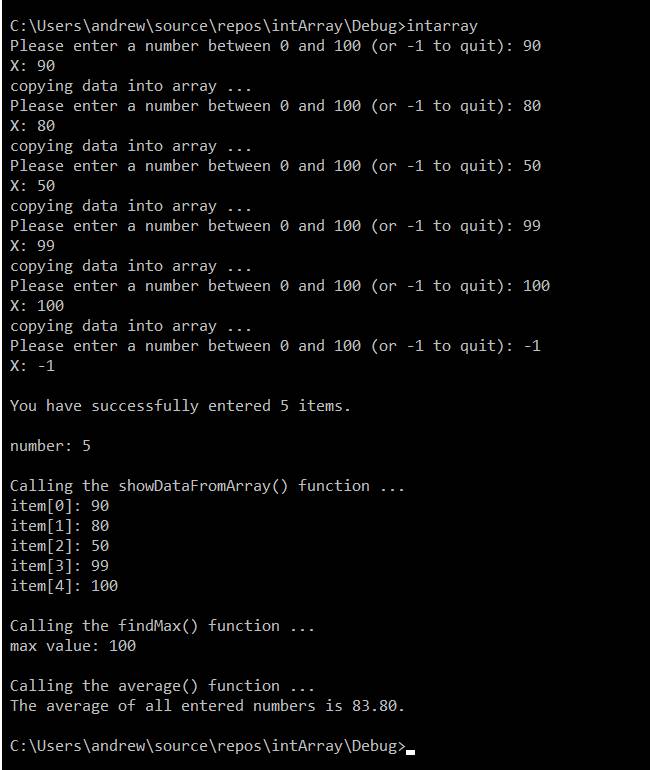|
T. Andrew Yang Email:
yang@uhcl.edu Web page
: http://sce.uhcl.edu/yang/ Tel.: (281) 283-3835 |
last updated 3/29/2019:
corrected Lab 7 2/16/2019:
Corrected Lab 3 (to hand-in) 1/21/2019:
Labs one and two published |
||||||||||||||||||||||||||||||||||||||||||||||||||||||||||||||||||||||||||||||||||||||||||||||||||||||||||||||||||||||||||||||||||||||||||||||||||||||||||||||||||||||||||||
|
Note: An important part of problem solving is correct
understanding of the given problem. -
Try to have a good grasp of
the problem before starting the process of finding the solution(s). -
Use any resources, including
the instructor, the TA, your classmates/friends, and online resources to
ensure that you have correctly understood the given problem. -
While trying to figure out
the solution(s), continue to verify your understanding of the problem. 1.
Lab 1 Total points= 100 1.1.
(20 pts)
Visit the
class discussion group (see the syllabus for the URL) and complete the
following tasks: 1.1.1.
Configure
your membership settings, so each
email sent to the group will be forwarded to your preferred email address
(that is, the email account that you regularly check each day). 1.1.2.
Post a message with your full name as the subject line. In your
post, briefly introduce yourself (including your full name) and one item you
most desire to learn in this class. 1.1.3.
Throughout
this class, you shall regularly visit the discussion group to find recent
announcements and reminders, and to participate at discussions. 1.2. Developing
C Programs 1.2.1. Figure 1 shows a sample C program.
Figure 1.1. A sample C program
Note: The source program as shown in Figure 1.1 may
contain special characters when being saved into a text file. Fix the errors
by replacing/retyping those characters using a text editor. 1.2.2. Suppose that program is saved as a text file named test.c. Figure
1.2 is a screen snapshot that shows commands used to compile and execute that
program, using the Tiny C Compiler (tcc), and the
sample user input and the output produced by that program. |
|||||||||||||||||||||||||||||||||||||||||||||||||||||||||||||||||||||||||||||||||||||||||||||||||||||||||||||||||||||||||||||||||||||||||||||||||||||||||||||||||||||||||||||
|
Decimal |
Binary |
Hexadecimal |
|
32 |
|
|
|
33 |
|
|
|
34 |
|
|
|
35 |
|
|
|
36 |
|
|
|
37 |
|
|
|
38 |
|
|
|
39 |
|
|
|
40 |
|
|
|
41 |
|
|
|
42 |
|
|
|
43 |
|
|
|
44 |
|
|
|
45 |
|
|
|
46 |
|
|
|
47 |
|
|
|
48 |
|
|
|
49 |
|
|
|
50 |
|
|
|
51 |
|
|
|
52 |
|
|
2.1.2. (10 pts) With 5 binary bits, how many different states or
values can be represented?
Ans:
________________
Show all the different states that can be
represented by those bits:
_________________________________________________________________________________
_________________________________________________________________________________
_________________________________________________________________________________
_________________________________________________________________________________
_________________________________________________________________________________
2.1.3. (30 pts) Complete the following table by filling in missing
values.
|
Decimal |
Binary |
Hexadecimal |
|
|
100000 |
|
|
|
100001 |
|
|
|
100010 |
|
|
|
100011 |
|
|
|
101010 |
|
|
|
101011 |
|
|
|
101100 |
|
|
|
110101 |
|
|
|
110110 |
|
|
|
110111 |
|
|
|
111000 |
|
|
|
111010 |
|
|
|
111100 |
|
|
|
111110 |
|
|
|
111111 |
|
|
|
1111110 |
|
|
|
1111111 |
|
|
|
11111110 |
|
|
|
11111111 |
|
|
|
100000000 |
|
2.1.4. (10 pts) Suppose a sensor device has 8 bits to store data
values. With all the bits being used to represent zero and positive
integer values, what are the integers that can be represented by those bits?
List them all. Highlight the smallest and the largest
values.
2.1.5. (10 pts) Suppose a sensor device has 8 bits to store data
values. With the leftmost bit being used to represent the sign, and the rest
of the bits being used to represent integer values, what are the integers
that can be represented by those bits? List them all. Highlight the smallest
and the largest values.
2.1.6. (5 pts) Show the sum of the following pairs of binary
numbers.
2.1.6.1.
101010b
+ 10100b = ____________
2.1.6.2.
010011
b + 10010b = ____________
2.1.6.3.
101001b
+ 10101b = ____________
2.1.6.4.
101001b
+ 10101b = ____________
2.1.6.5.
101010b
+ 10101b = ____________
2.1.7. (5 pts) Explain what data overflow means. Use an example to
explain what it is.
Go to the Index
Total points= 100
3.1. A C program is composed of functions, each of which has a
clearly-defined functionality. A function may call other functions to perform
specific tasks. The calling relationship can be illustrated using a calling graph.
3.1.1.
Study and run the following program to understand how it
works and, in particular, how the various functions are related to each
other. Draw a calling graph to clearly show the order of function calls
and the returned value, if applicable.
|
#include <stdio.h> int f1(int); //function declaration void f2(int); void f3(void); char f4(int); int main() { //printf("Hello.
Welcome!\n My name is ...\n"); printf("calling
f1() ...\n"); int
f1Result = f1(23); printf("f1Result
= %d\n", f1Result); f3(); } //main() int f1(int data) { printf("in
f1(): data = %d\n", data); data
= data / 5; f2(data); return
data; } void f2( int data) { printf("in
f2(): data is %d\n", data); char
f2Char = f4(55); printf("f2Char:
%c\n", f2Char); } //f2() void f3() { printf("Bye.\n"); } //f3() char f4(int x) { printf("in
f4(): x is %d\n", x); return
'X'; } //f4() |
3.1.2.
Revise the above program by replacing the commented-out
line (//printf("Hello. Welcome!\n My name is ...\n"); ) with a
function call greeting( ). That
function will print a simple greeting message followed by introducing your
own name. For example, when the greeting(
) function is called, it may display the following greeting message on
the screen:
Hello. Welcome!
My name is John Doe. (Note:
Use your real name.)
To hand in:
3.1.2.1.
(30 pts) The calling graph from 3.1.1
above.
3.1.2.2.
(40 pts) The
revised C source program per instructions above.
3.1.2.3.
(30 pts) Before
the lab is due, give the TA a face-to-face demo during his/her office hours
by showing how you’d run the revised program using one of the
computers in the lab.
Go
to the Index
Total points= 100
4.1. A C program is composed of functions, each of which has a
clearly-defined functionality. Write a function called numericToLetterGrade( ) that returns the letter grade
of a given numeric value, according to the following table.
|
Percentile |
Grade |
|
Percentile |
Grade |
|
90% or
above |
A |
|
70% -
73% |
C |
|
87% -
89% |
A- |
|
67% -
69% |
C- |
|
84% -
86% |
B+ |
|
64% - 66% |
D+ |
|
80% -
83% |
B |
|
60% -
63% |
D |
|
77% -
79% |
B- |
|
57% -
59% |
D- |
|
74% -
76% |
C+ |
|
Less
than 57% |
F |
For
example, numericToLetterGrade(91) returns A, while numericToLetterGrade(77) returns B-,
and so on.
Hint
#1: Use nested if … else … to determine the letter
grade.
Hint
#2: The function should return a string. The following sample program
demonstrate how to write a function that returns a string.
|
#include <stdio.h> char * fReturnString(); int main() { char
* aString = fReturnString(); printf("value
of aString: %s\n", aString); } char * fReturnString() { return
"Have a good day!"; } |
The main( ) function should first ask the
user for a numeric value between 0 and 100, and then calls the numericToLetterGrade( ) function to
get the letter grade. Once the letter grade is returned, it will be printed
on the screen.
4.1.1. (30 pts) Draw a flowchart to show the
logic of the numericToLetterGrade( ) function.
4.1.2. (40 pts) The source program with proper
comments.
4.1.3. (30 pts) Before
the lab is due, give the TA a face-to-face demo during his/her office hours
by showing how you’d run the revised program using one of the
computers in the lab.
Go
to the Index
Total points= 100
5.1. Write a program to get
a person’s height and weight first, and then print that person’s BMI
by using the formula as given in http://www.calculator.net/bmi-calculator.html.
Note: Your program should be constructed the same
way as shown below. That is, what you need to do is to complete all the
undefined functions (getHeight( ), getWeight( ), etc.) Do not change the
signatures of those functions. The printBMI( ) function will print the
calculated bmi, and also indicate the category of that person (underweight,
normal, or overweight).
#include <stdio.h>
int getHeight() {
} //getHeight()
double getWeight() {
}
float calculateBMI(int height, double weight) {
}
void printBMI(float bmi) {
}
int main () {
int
height;
height
= getHeight();
double
weight;
weight
= getWeight();
float
bmi=0;
bmi
= calculateBMI (height, weight);
printBMI(bmi);
} //main
Below is a sample output of running this
program:

5.1.1. (30 pts) Draw a flowchart to
show the logic of the calculateBMI( ) function.
5.1.2. (40 pts) The source program with
proper comments.
5.1.3. (30 pts) Before the lab is due,
give the TA a face-to-face demo during his/her office hours by showing how
you’d run the revised program using one of the computers in the
lab.
Go
to the Index
Total points= 100
6.1. Write a program that
asks the user to continue to enter two numbers (at a time). For each pair of
numbers entered, the program calculates the product of those two numbers, and
then accumulate that product. For each pair of numbers entered, the program
also prints the entered numbers, their product, and the accumulated products.
The process will continue until the user enters two zeros. See the following
screen snapshot for a sample running of the completed program.
Hint: Use a while
loop.

Requirements:
Write your program such
that it generates screen output as shown above.
6.1.1.
(30 pts) Write a pseudocode to
show the logic of your program.
6.1.2. (40 pts) The source program with
proper comments.
6.1.3. (30
pts) Before the due
time, give the TA a demonstration of your running program.
Go to the Index
Total points= 100
7.1. The following is a
partially completed program that continues to (a) first display a menu of
commands, and then (b) asks the user to choose 1 to enter a grade or 0 to quit
the input process. Your job is to complete the main(
) function by implementing a
do
… while loop.
|
#include <stdio.h> void displayMenu( ); int getInput( ); void main() {
/*
Build a loop that will continue to call the displayMenu() and **
the getInput() functions, until the user enters 0 to quit. */
printf("\nBye.\n"); } //main void displayMenu() {
printf("\n");
printf("Enter 1 to enter a grade.\n");
printf("Enter 0 to quit the input process.\n");
printf("Input? "); } int getInput() {
int input;
scanf("%d", &input);
return input; } |
|
|
Requirements: Write your program such that it
generates screen output as shown above.
7.1.1. (30 pts) Write a pseudocode
to show the logic of your main function.
7.1.2. (40 pts) The source program
with proper comments.
7.1.3. (30 pts) Before the due time, give the TA a
demonstration of your running program.
Go
to the Index
Total points= 100
8.1. The following sample
program gets data from the user, and then enters those data into an integer
array. The function getDataIntoArray(
) returns the number of items successfully entered into the array.
Sample screen of running the program is shown
in Figure 6.1.
|
#define _CRT_SECURE_NO_WARNINGS #include <stdio.h> #define SIZE 100 void initializeArray(int[SIZE]); //initialize each element to be zero int getDataIntoArray(int[SIZE]); //This function takes as a parameter an array of
strings. void showDataFromArray(int[SIZE], int); //show all the elements in a given array void findMax(int[SIZE], int); //find the largest number in the given array double average(int[SIZE], int); //return the average of all numbers in the given
array void main() { int intArray[SIZE]; initializeArray(intArray); int number
= getDataIntoArray(intArray); printf("number: %d\n", number); /* Uncomment the following
statements when new functions have been coded. printf("\nCalling
the showDataFromArray() function ...\n"); showDataFromArray(intArray, number);
//Display all the names
currently in that array. printf("\nCalling
the findMax() function ...\n"); findMax(intArray, number); printf("\nCalling
the average() function ...\n"); printf("The average of all
entered numbers is %.2f.\n", average(intArray, number)); */ } void initializeArray(int arr[SIZE]) { for (int i = 0; i < SIZE; i++) arr[i] = 0; } int getDataIntoArray(int
arr[SIZE])
{ int num =
0; int index
= 0; do { printf("Please enter a number
between 0 and 100 (or -1 to quit): "); scanf("%d", &num); printf("X: %d\n", num); if (num !=
-1) { printf("copying data into array
...\n"); arr[index] = num; index++; } } while
(index < SIZE && num !=
-1); if (index
> 0) printf("\nYou
have successfully entered %d items.\n\n", index); else printf("No item was
entered.\n"); return index; } |
|
Figure 6.1 Sample output of getting
user data into an array |
8.2. Design and implement
functions that process the array intArray created in the sample program, including showDataFromArray( ), findMax( ), and average( ).
Sample calls to those functions are shown as comments in the sample program.
-
The function showDataFromArray( ) takes the intArray
and the number of elements as parameters, and shows each of the elements
currently in the array (along with its respective index value in that array).
-
The function findMax( ) searches through the intArray to find the largest number currently in that
array.
-
The function average( )
calculates and returns the average of all numbers currently in that array.
Implement the showDataFromArray( ) and
the findMax( ) functions. When ready, uncomment the
respective sample calls in the main( ) function, and
then run the revised program.
Your revised program should generate screen
output as shown in Figure 6.2.
|
Figure 6.2 Sample screen output of
running the revised program |
To hand in:
8.2.1. (30 pts) Draw a flowchart to
show your logic of the findMax( ) and the average( ) functions.
8.2.2. (40
pts) The source program with proper comments.
8.2.3. (30
pts) Before the lab is due, give the TA a face-to-face demo during
his/her office hours by showing how you’d run the revised program using
one of the computers in the lab.
Go
to the Index



